History painting Genoese School
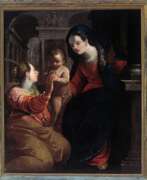

Giovanni Andrea Ansaldo was an Italian painter active mainly in Genoa. He trained under Orazio Cambiasi and possibly collaborated with Bernardo Strozzi. Ansaldo's works are typical of the Genoese eclecticism of the early 17th century, influenced by Flemish artists. Ansaldo was responsible for the fresco decoration of the cupola of the Basilica della Santissima Annunziata del Vastato of Genova. His Annunciation fresco is considered the first true Baroque painting in the city.
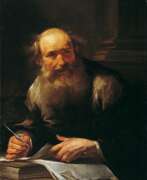

Gioacchino Assereto was a prominent Italian Baroque painter, celebrated for his dramatic and emotionally charged works that often depicted religious and historical subjects. Born in Genoa in 1600, Assereto's early career was marked by his apprenticeship with Luciano Borzone and Giovanni Andrea Ansaldo, which laid the foundation for his development as an artist. His paintings are known for their vibrant light effects and dynamic compositions, a style significantly influenced by Caravaggio during Assereto's brief visit to Rome in 1639. This influence is evident in his masterful use of chiaroscuro and sfumato techniques, which added depth and realism to his works.
Assereto's oeuvre includes powerful pieces like "The Lamentation," notable for its intense shadows and dramatic portrayal of Christ's body, and "The Torture of Prometheus," a work that showcases his later years' shift towards more emotional and theatrical compositions. His "Death of Cato" and "Ecce Homo" further illustrate this evolution, moving from refined styles to bold, expressive techniques that emphasize violent emotions through the dramatic effects of light.
Throughout his career, Assereto's works were highly regarded, with contemporary Genoese biographer Raffaele Soprani praising him as incomparable. His paintings can be found in significant collections, including the Musei di Strada Nuova in Genoa, the Cummer Museum of Art and Gardens, and the National Gallery in London. Assereto's legacy extends beyond his lifetime, with his son Giuseppe Assereto and others producing many copies of his work, ensuring the endurance of his artistic influence.
For art collectors and experts, Assereto's work embodies the Baroque spirit with its emotional intensity and technical mastery. His ability to convey deep psychological tension and his innovative use of lighting make his paintings a valuable study in the evolution of Baroque art.
If you're passionate about Baroque painting and interested in staying updated on sales and auction events related to Gioacchino Assereto's works, consider signing up for updates. This subscription will ensure you're informed about new opportunities to acquire pieces by this master of the Baroque period, enriching your collection with the depth and drama of Assereto's art.
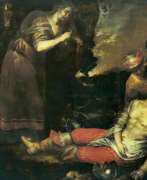

Luciano Borzone was an Italian painter of the late Mannerist and early Baroque periods, working mainly in Genoa. After an apprenticeship with Filippo Bertolotto, his uncle, Duke Alberigo of Massa Lunigiana, patronised his work as a pupil of Cesare Corte.
Luciano Bordzone was an outstanding portrait painter. In Genoa he painted the Purification for the church of San Domenico and the Baptism of Christ for the church of Santo Spirito.
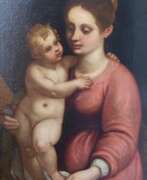

Bernardo Castello (or Castelli) was an Italian painter of the late-Mannerist style, active mainly in Genoa and Liguria. He is mainly known as a portrait and historical painter. He was apprenticed under Andrea Semino and Luca Cambiaso, then travelled throughout Italy, meeting other painters and creating his own particular style. During his career he painted many works and was appreciated by famous poets with whom he had friendships. Beside working in Genoa, Castello was employed in Rome and worked also for the Duke of Savoy, Charles Emmanuel I.
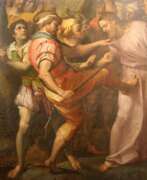

Giovanni Battista Castello was an Italian historical painter. His best-known works are the paintings on the vault of the Basilica della Santissima Annunziata del Vastato. He was an architect and sculptor as well as painter. He painted of the Martyrdom of St. Sebastian in the monastery of San Sebastiano. He worked on various projects with his friend Cambiaso, including in a chapel for the Duomo di San Lorenzo.


Giovanni Benedetto Castiglione or Il Grechetto was an Italian Baroque painter, draftsman and printmaker.
He is one of the prominent representatives of the Genoese school, working at various times in Genoa, Venice and Rome. Castiglione is believed to be the author of monotype, a type of graphic art and a technique of printmaking that is not engraving.
Castiglione was a versatile and prolific painter, while working in a wide variety of styles that he studied carefully. His paintings pay tribute to Rubens, Van Dyck and Bernardo Strozzi, who worked in Genoa, and his etchings pay tribute to Rembrandt. Castiglione painted expressive portraits, historical and religious works and landscapes, and excelled in rural scenes with animals.
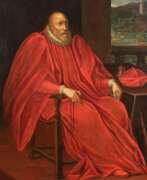

Andrea Semini was an Italian painter of the late-Renaissance, active mainly in his native Genoa. He was a son and pupil of the painter Antonio Semini. After studying some time under his father, together with his brother Ottavio he went to Rome, and they realized some work in collaboration (frescoes in the Palazzo Marino in Milan). He is well known for his frescoes in several palaces in Genoa, painting for churches and portraits.